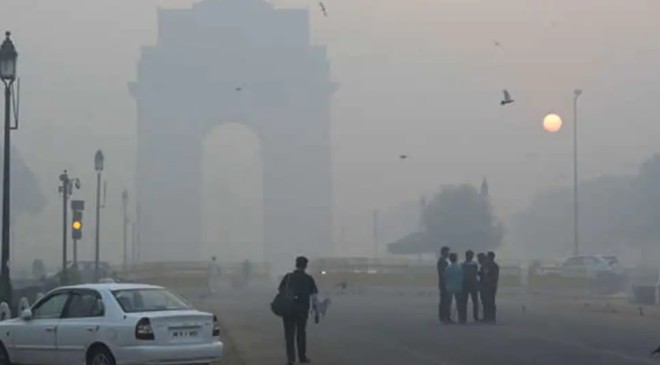New Delhi: Pollution levels in Delhi and its suburbs increased further overnight with the Air Quality Index (AQI) in the Capital falling in ‘Severe’ category in several areas on November 22, according
New Delhi: Pollution levels in Delhi and its suburbs increased further overnight with the Air Quality Index (AQI) in the Capital falling in ‘Severe’ category in several areas on November 22, according to the Central Pollution Control Board. This morning, the residents of Delhi awoke to a dense smog blanket, leading to decreased visibility and aggravating their respiratory challenges.
Read More: National Herald Case: Enforcement Directorate’s Big Action, Assets Worth Rs 751 Cr Attached
AQI in Ashok Vihar at 405, in Jahangirpuri at 428, in Major Dhyan Chand National Stadium at 404, in Dwarka Sector 8 at 403. The Bawana station recorded alarming PM2.5 at 500 and PM10 at 452, both in the ‘severe’ category, although CO levels were marked ‘satisfactory’ at 86.
The Indira Gandhi International (IGI) Airport T3 witnessed PM2.5 levels at 429 and PM10 at 346, both falling under the ‘severe’ and ‘very poor’ category, respectively. The CO level was recorded at 95, maintaining a ‘satisfactory’ rating.
However, some parts of Delhi’s air quality stood at 348 on Wednesday morning at 6:30 am, which lies in the ‘very poor’ category according to the System of Air Quality and Weather Forecasting And Research (SAFAR).
ITO’s monitoring station reported PM2.5 at 411, categorised as ‘severe,’ while PM10 touched 340, labeled ‘very poor.’ CO levels were ‘moderate’ at 104, with NO2 at 119, falling into the same category.
AQIs between zero and 50 are considered ‘good’, 51 and 100 ‘satisfactory’, 101 and 200 ‘moderate’, 201 and 300 ‘poor’, 301 and 400 ‘very poor’, 401 and 450 ‘severe’, and above 450 ‘severe plus’.
The Delhi AQI has been consistently in the ‘Poor’ to ‘Very Poor’ category ever since the onset of winter, when farm fires begin in the neighbouring states of Punjab and Haryana. This is exacerbated during the Diwali festival as people participate in celebrations bursting crackers and fireworks.
Read More: PM Modi To Host Virtual G20 Summit Today, Russia’s Vladimir Putin To Attend
Delhi Worst and Best AQI
Delhi was the most polluted city in the world on November 14, followed by Dhaka Lahore and Mumbai, as per IQAir, a Swiss company that specialises in air quality monitoring. Delhi had recorded its best air quality on Diwali day in eight years on Sunday, with its 24-hour average AQI settling at 218 at 4 pm.
However, the bursting of firecrackers till late Sunday night led to a spike in pollution levels amid low temperatures.
“It’s evident that the spike in pollution levels post Diwali is due to two factors — firecracker bursting and farm fires — with fireworks being the predominant reason in this case,” an official of the Commission for Air Quality Management (CAQM), a statutory body responsible for formulation of strategies to reduce pollution in Delhi-NCR, told PTI.
Read More: NPCI Instructs Payment Apps To Deactivate Inactive UPI IDs By This Date
‘Cannot Take Court For Granted’: SC Lashes Out At Punjab Govt As Delhi AQI Dips
A Division Bench of the Supreme Court hearing the matter on the worsening pollution levels in Delhi on Tuesday directed the Punjab government to ensure that the crop-burning was halted immediately and to take steps, including depriving the non-compliant farmers of MSP (Minimum Support Price) or ensuring zero-residue crop processing, to ensure the goal of trapping the Delhi Air Quality Index (AQI) within the ‘Moderate’ category.
The two-judge bench of Justices SK Kaul and Sudhanshu Dulia even suggested that perhaps the farmers were not entirely to blame. “The farmers are being made a villain and are not being heard here in the court. They must have some reasons for burning stubble,” the bench observed, directing the Punjab government to take steps like Haryana, which offered financial incentives to farmers to induce environment-friendly crop processing habits.
“The state of Punjab should take a cue from the state of Haryana in the manner in which financial incentives are given,” the bench said.



































